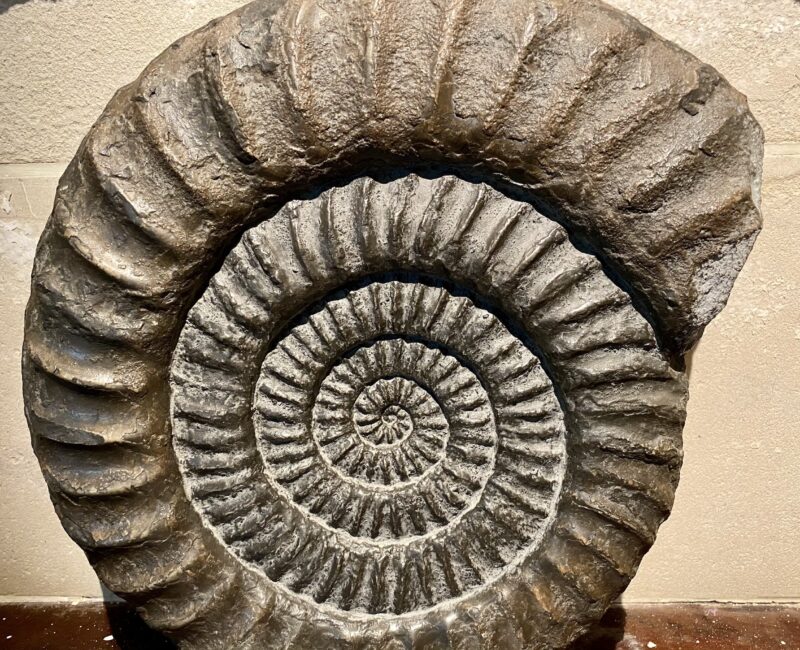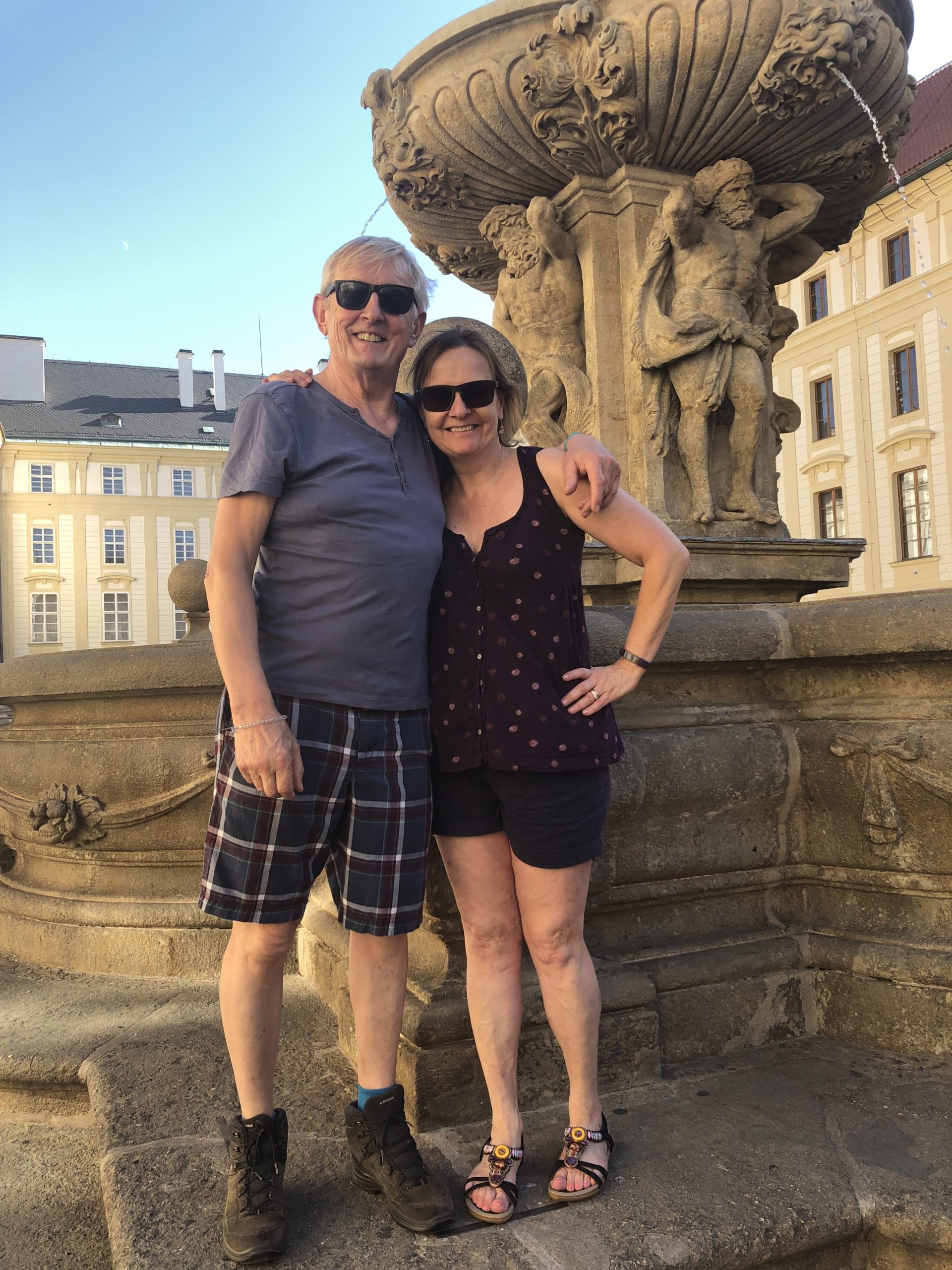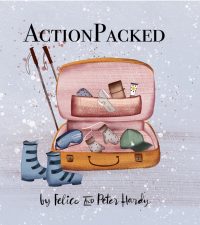
Ammonite from Lyme Regis Museum. Photo: © F.Hardy
Peter Welcome to our travel podcast. We’re specialist travel writers and we’ve spent half a lifetime exploring every corner of the world.
Felice We want to share with you some of our extraordinary experiences and the amazing people we’ve met along the way.
David So Kate could learn how to speak, not with a Dorset accent but with a Lyme accent. I suppose that’s the kind of detail that wins Oscars.
Paddy We’ve taken over 100,000 people fossil hunting, one of the things I love about my job is the most complicated tool I use is a bit of metal on the end of a stick.
Peter This week, we’re in the quaint and historic resort of Lyme Regis on the southwest coast of Britain, 150 miles – that’s 240 kilometres from London. Lyme, as the locals call it, is the fossil-finding capital of Europe. Normally, I think it’s fair to say that for most of us palaeontology, the study of fossils, doesn’t necessarily set the pulses racing. But the release this autumn of a major romantic movie, directed by Francis Lee starring Kate Winslet and Sioarse Ronan, is about to thrust Lyme into the limelight once again.
Felice Yes, Lyme is no stranger to celebrity status. Back in the 1980s, Meryl Streep‘s Oscar-nominated portrayal of John Fowles’ book, The French Lieutenant’s Woman, did wonders for tourism here and now, Ammonite tells a story of impoverished fossil hunter, Mary Anning, who in the early 1800s became a celebrity because of her remarkable discoveries. The movie centres on her supposed love affair with the geologist, Charlotte Murcheson, wife of the fox-hunting Army officer. Charlotte was someone from the extreme opposite end of the social spectrum.
It appears that anyone visiting Lyme can, with a bit of luck, just pick up a giant 160 million-year-old shrimp from a puddle on the beach and take it home with them. Finding the petrified parts of an actual dinosaur takes a lot more skill, but this does actually happen. Not for nothing is this stretch of seaside known as the Jurassic Coast, a designated UNESCO World Heritage site.
Peter To find out what makes Fossils sexy, we’re going in search of David Tucker, director of Lyme Regis Museum, and his fossil-hunter-in-residence, Paddy Howe. Now, Paddy acted as Kate Winslet’s guide and technical mentor throughout the filming last year. But first, let’s take a closer look at our surroundings. So here’s the Cobb, the old wall that protects the fishing boats and yachts at anchor in the harbour.
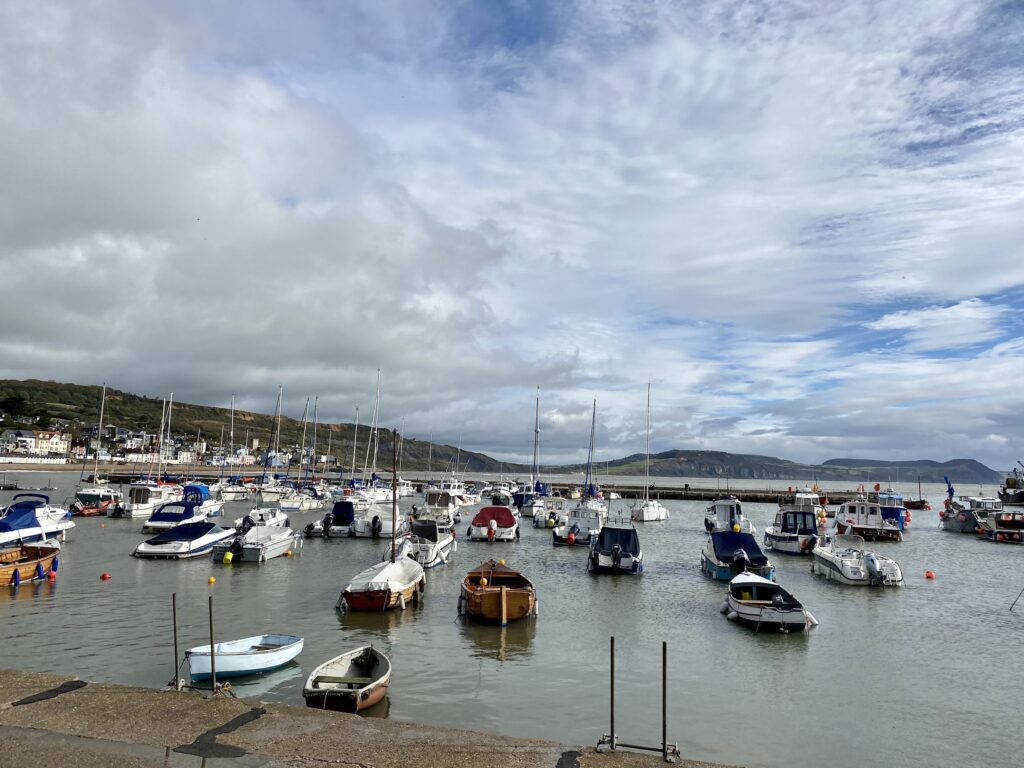
Photo: © F.Hardy
Felice It’s a small place, population is less than 4,000 people.
Peter Let’s take a walk down here.
Felice It’s really beautiful. Scenery is gorgeous with the cliffs on one side and then a really long stretch of beach, some nice old houses unfortunately ruined by modern plastic buckets and spades and things. Otherwise you could be in the 19th century, still.
Peter Still, you feel not a lot has changed, really, especially around the Cobb. There are people right now I see people walking along the edge of it and the weather is quite stormy today. It’s pretty dangerous to stand up where Meryl stood for some hours. it looks took like in the movie – I suspect it was a double doing it. But Felice, why don’t you climb those stone steps there ? It looks a bit wet. Be careful, see what you can see when you get the top.
Felice Well, I went up the steps and didn’t go onto the Cobb itself because it looks so slippery and slimy and the waves are actually coming right across it. So I don’t fancy going on it. And apparently someone died not that long ago – they were swept into the water by wave.
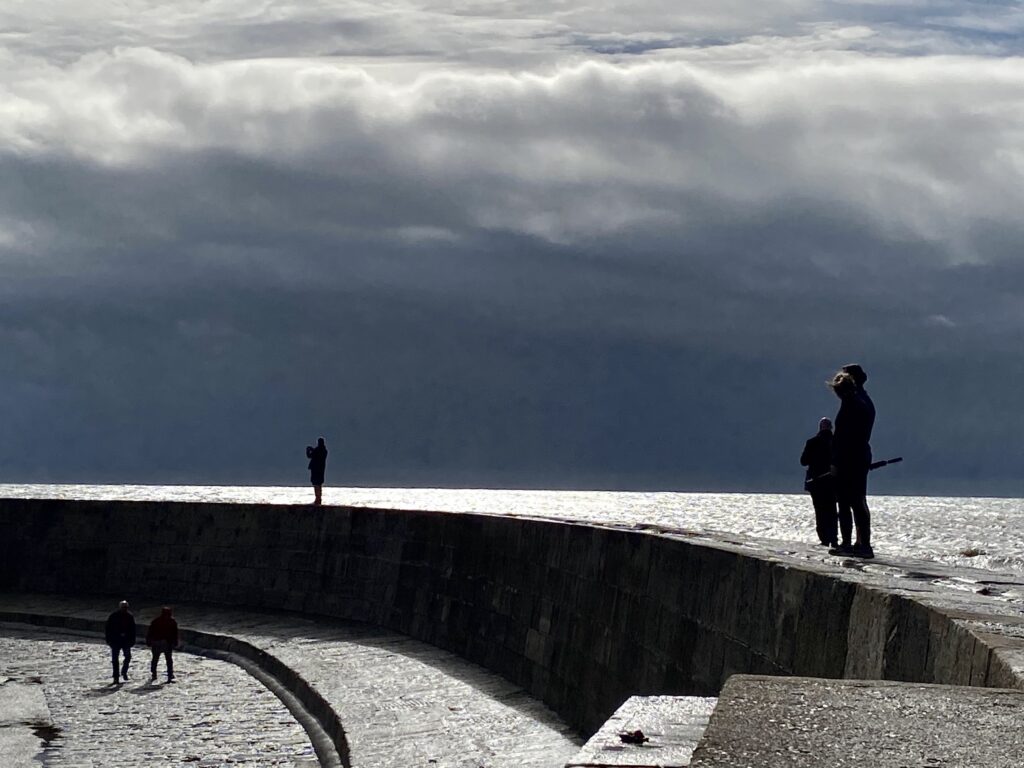
The Cobb. Photo: © F.Hardy
Peter And the wave then came back and crushed them against against the Cobb, and that was that. So you do need to be careful. Too many people have seen the movie and want to revisit the scene, but I think it’s one to be quite wary of. So let’s walk down the beach towards the museum.
Felice Lots of seagulls, and there’s a little old theatre right next to the museum. And it’s a really pretty place, lots of atmosphere.
Peter It’s much smaller and much steeper then I imagined. The main street going up is really quite a bit of a climb.
Felice Some nice shops and lots of really nice seafood restaurants, too.
Peter Yes, seafood’s a big thing for me – and you. Let’s go and book somewhere for dinner. But first of all, we need to go and find David and Paddy.
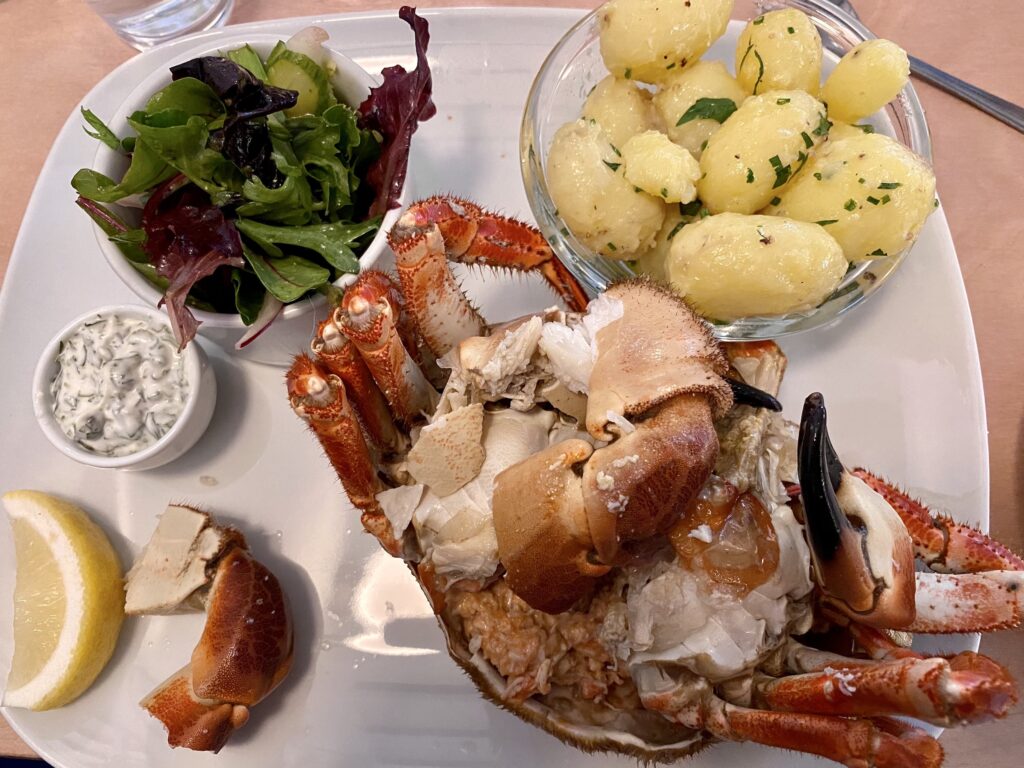
Photo: © F.Hardy
So, David, it’s extraordinary how much Lyme Regis has changed in recent decades.
David Well, the museum and Lyme has changed hugely in about the last 15 to 30 years. I mean, obviously, where we are in the museum, it’s pretty much doubled in size since 2017, which has been an interesting challenge. But the town itself has significantly changed since the 1990s, with the extension in the sea defences.
Peter Yes, a little bit earlier than that, there was John Fowles’ book, The French Lieutenant’s Woman, which was set here, and then the movie with the unforgettable scene of Meryl Streep standing alone and mysterious on the storm-lashed Cobb, the old harbour wall.
David John’s book was written in the late ‘60s and the film was made in ‘81 to ‘82. Of course, as you may or may not know, John worked here. He was honorary curator at the museum for many years, and I have his chair in my office. It’s a bit battered after 30-odd years. But I just think if I’ve got a great author’s chair, I’m going to keep that one. So Lyme was rediscovered in many ways, culturally, by the book. But now that Mary Anning is on the school curriculum and, of course, this the film coming out about her, we’ve rediscovered Lyme’s primary role as the home of palaeontology.
Peter Yes, it was the place that time forgot. But now time is absolutely rediscovered, I think.
David Well, I’m often asked, what is it about a place like Lyme and why has it done so well in recent years? And I actually think that the world changed with the making of the film, Jurassic Park. Special effects now enable us all to see what we think dinosaurs would have looked like. When I was a kid in the ‘60s and early ‘70s one looked at a black and white drawing in a book. And, you know, I actually think the whole series of films – the BBC TV series like Walking With Dinosaurs, a good 15, 20 years back now, really just changed the rules. And I’m sure that’s why dinosaurs in palaeontology is so popular again.
Peter So when did Mary Anning and go onto the school curriculum? Was that recent?
David I think it was probably about 2015, 2016 time.
Felice So you have groups of schoolchildren that come here to the museum?
David Oh, yes. Well, under normal conditions we do. Although we’re not a big museum physically, we do like to point out that we’ve got the biggest museum gallery in England, which is Mary Anning’s beach, and where I think I’m told that we’re the most visited museum by schools in Dorset. And what we do with a lot of those groups is take them out onto the beach and they get a chance to fossil hunt and learn about the conditions under which Mary worked and lived. In fact, the museum is built on the site of her house.
Peter And of course the film, which I’m told has red-hot romantic scenes between the two women, may not be exactly what every primary school teacher wants to explain to his or her class.
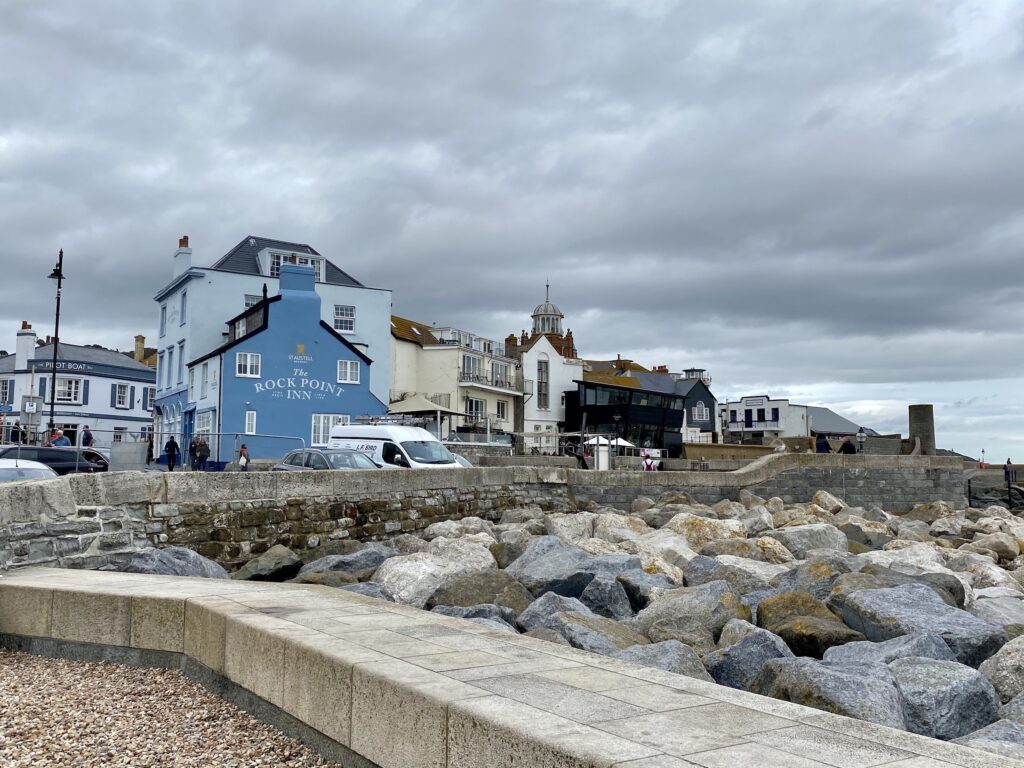
Part of Lyme Regis centre. Photo: © F.Hardy
David Well, I think the film is one that little children won’t be able to see, shall we say. We’re absolutely relaxed about the film. We were scientific advisers on the film. One of our team, who’s a Lyme-born woman, was the guide for Kate Winslet’s accent, and they spent a great deal of time together so Kate could learn how to speak, not with a Dorset accent but with a Lyme accent. I suppose that’s the kind of ear for detail that wins Oscars.
So we also made sure that Paddy, one of our really good geologists, made sure that Kate Winslet knew how to crack open a rock and find a fossil and look like she did it every day
Peter That’s not easy.
David No, but she took it in her stride.
Felice So can people find fossils on the beach nowadays?
David Oh, yes. One of the reasons we are a World Heritage site is because a constant erosion of the rocks means that as rocks erode, you simply can find the same fossils now that people would have found 200 years ago. It’s as a result of coastal erosion. So as the rocks are all the same age, you can find fossils of the same age. The director, Francis Lee, he was a really nice man and came here and did a fossil walk – it must have been about two and a half years ago. And my geologist Paddy and I had a long conversation with him and he asked us to keep quiet about the project. So we did.
Then a few months later on, I met one of the producers and gave him a bit of help with locations. You know that if you work with the film industry or with any media company, I’m sure you’ll know, they ask you to sign the little piece of paper that says you keep quiet. We signed them about three years after we knew the project was on.

Felice So what can we see in the museum relating to Mary Anning, apart from fossils?
David Well, Mary Anning was a poor woman and very little of that which she owned survives. We have two or three fossils in the museum that are on loan, and they are fossils that we know that Mary discovered, we also have fossils that were discovered by a lady called Elizabeth Philpot, who again is portrayed in the film, a very interesting and very important fossil hunter in her own right whose family paid for this building and whose collections are in Oxford Museum of Natural History. But when it comes to things that Mary actually owned, the only things that we know of other than her fossils are letters and what’s called a commonplace book that belongs to our neighbours at Dorset County Museum.
Peter So tell us, for the benefit of people who don’t know about Mary Anning. Who was she and when was she born and how did she become world famous?
David Well, she became famous, of course, after death. But she was born in 1799, basically where we’re standing. And she and her elder brother.. in fact her elder brother was a key part of this as well…they famously found an ichthyosaur skull on the beach in…I think it’s 1811, when she was only about 11 or 12.
Peter It’s a bit like a crocodile?
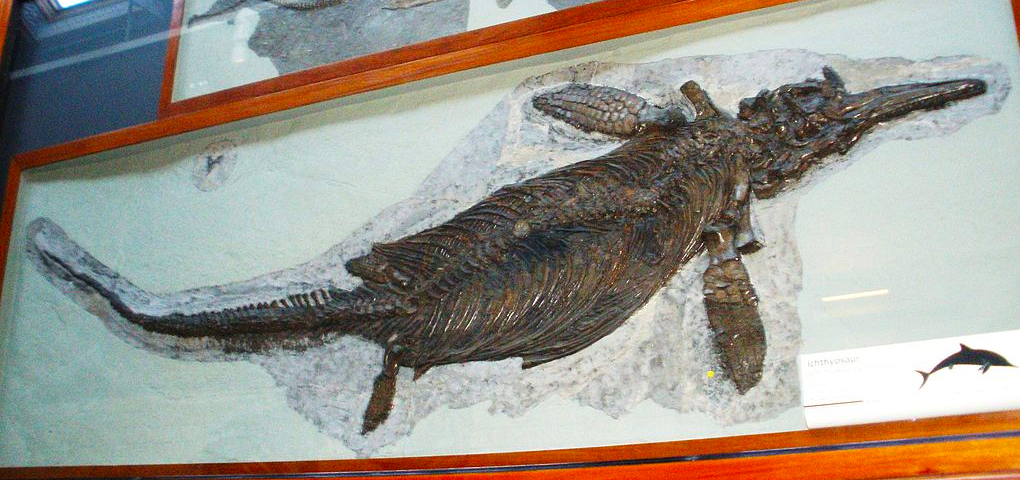
Fossil of Ichthyosaurus extinct reptile in the Natural History Museum, London. Photo: Commons Wikimedia
David Yes, well, people thought they were like crocodiles. Actually, they’re much more like fish. If you Google ichthyosaur, if you can spell it – it’s not easy, you can find out what they looked like. They are giant marine reptiles from the Jurassic period. So they’re big and fierce like dinosaurs, but they’re not landlubbing so they’re not actually dinosaurs. And the rocks around here are full of the fossils of these creatures. And that’s what Mary discovered.
And what was lucky was, of course, people would have been discovering these things all the time. But in previous times, there wouldn’t have been the perception – in what was developing the world of science – of what these things were. People would have thought in the past that they were dragons. Or one idea about the ammonite was a snake that bitten its own tail, you know.
So Mary was finding fossils at the time when, I suppose you could put it and say that the age of the Earth, as in Biblical terms, was being challenged by scientists – and indeed by many clergymen, because many of the early scientists were, in fact, clergymen who used their spare time to record the wonders of God’s universe and God’s world and then discovered things that didn’t fit into the Bible. So it’s a very interesting process and perhaps nowhere near as antagonistic as one might think from what one reads today.
Peter So Mary was a local girl, grew up, born here, as you say, where we’re standing. And she grew up in an impoverished family.
David Well, yes, her her father was a carpenter. They were only two out of their nine children survived: Mary and Joseph. Their father died, I think about 1809, after a bad fall on the Black Ven, which is a cliff to the east of the town, where he was looking for fossils. But really, what little we have of the history of Richard Anning, her father, it may have been that there was some other chronic disease that he was suffering from as well. So basically, the Annings were left pretty poor. They’d lost their main trade, which was Richard’s carpentry. But the family always found ‘curios’, as people called fossils then, and sold them to the tourists that came here.
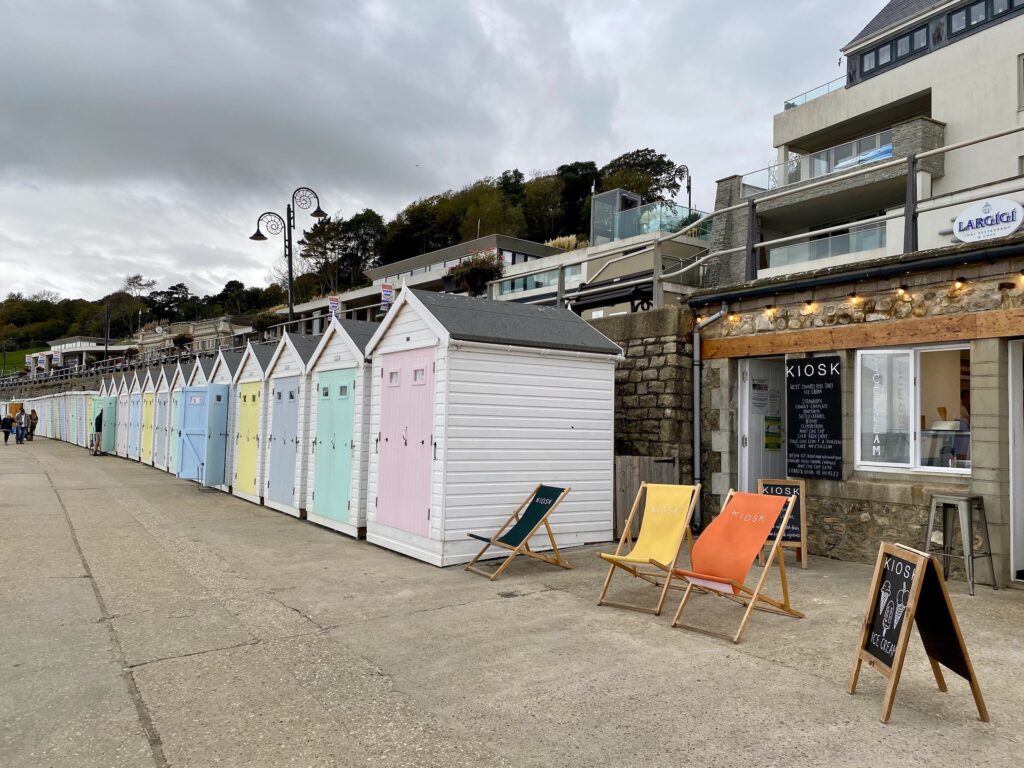
Beach huts at Lyme Regis. Photo: © F.Hardy
Peter And there were quite a lot of tourists and it was quite a seaside resort.
David Well, yes, it’s interesting in the area in that this is a kind of place that gets mentioned in Jane Austen books, people coming here to recover after the season in Bath. But I think what also one needs to remember is that there was a war going on, so many of the gentlemen and ladies – I suppose the gentleman – who would have done the European tour couldn’t do it.
Peter I know. A bit like now.
David Yes. Don’t get me started. So we can assume a lot of people, perhaps learned people that perhaps would have done Europe as part of their growing up and they’re being introduced to culture would have perhaps come to Lyme as well.
Peter David, thank you very much. Now, before we meet up with Paddy, let’s pop next door to the Marine Theatre. It played a supporting role in Ammonite and Gabby Rabbitt, from the theatre, is going to tell us all about it.

The theatre bar, which became the crew’s canteen. Photo: © F.Hardy
Gabby The film used the Marine theatre as the canteen and also the wardrobe and makeup department. So for a good couple of weeks we were full of all of the costumes and hats and all the extras. Local people would come in their ordinary clothing and then reappear dressed ready for the Mary Anning film. So it was wonderful. And whilst they were all here, they’d use Theatre Square to relax.
And so as I glanced out of my office window, I see all the extras gathered, having their sandwiches and whatnot in full costume. It was wonderful, it was very exciting to be part of the film. The town was full of excitement when all of the big lorries and all the film crews were here. So it was really special for us to be involved.
Peter Are you going to have a screening of the film here in the theatre?
Gabby We very much hope to have a screening of the film. Like I say, with so many local people playing a part and being extras and so much of their time was spent being involved with the film. It would be lovely to have a screening. It would be nice to have more than one. We’d like to have a week, ideally.
The theatre first emerged in 1806 as a saltwater bath house. It was right above the ocean so they could pump the water up from the ocean straight into these enormous baths where people would come and loll around in the water as a cure for their ailments. So that’s how the building first appeared. Then it changed into a sort of drill hall, a drill hall/theatre – it’s had lots of different uses – a cinema. But we’ve had the stage and we have been having entertainment on stage for 125 years. We celebrated our 125th anniversary this year just gone, with a very special performance with Sir Ian McKellen. It was a great year.
Peter Many thanks, Gabby and we wish the theatre well for the next 125 years.
Here’s Paddy Howe, no doubt back from yet another day searching the beach. As I said earlier, Paddy was the fossil hunting coach for Kate Winslet, who plays Mary Anning in the film. Paddy, what did this exactly involve?
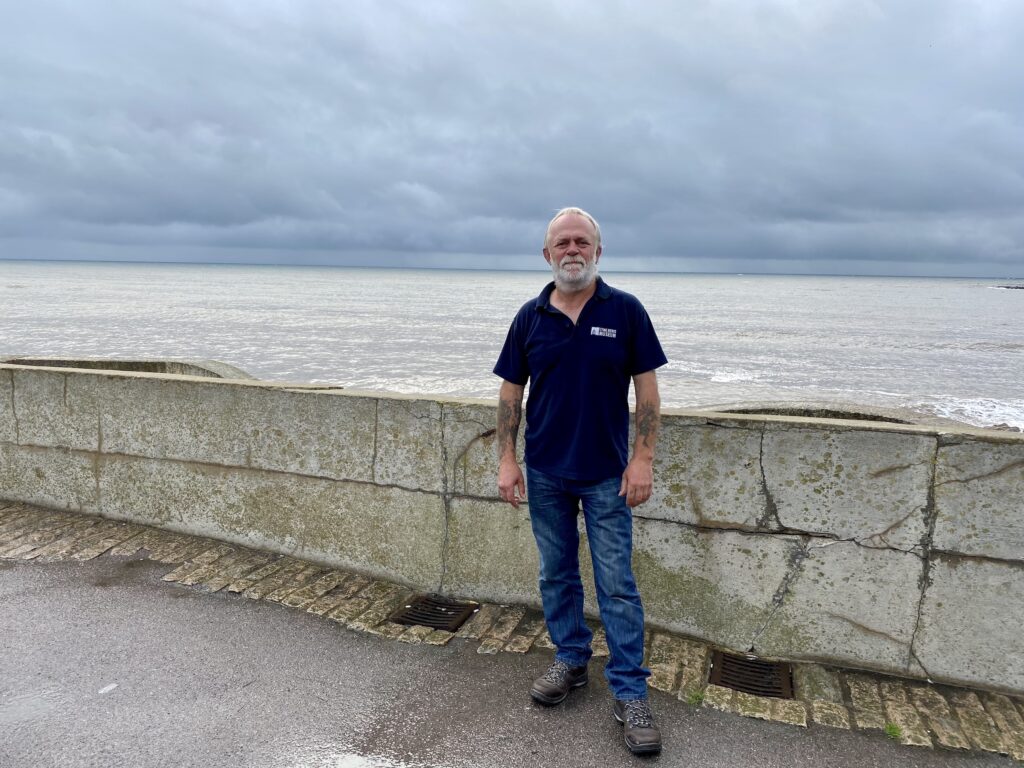
Paddy Howe. Photo: © F.Hardy
Paddy Just making sure that you have the right fossils in the right place, that everything looks right, the right sort of tools, all of those things.
Felice So we’ve never been fossiling. Can you tell us a bit about it, how you do it?
Paddy Sure. It’s fairly simple, really. So most of the time it’s walking around, looking at the ground. So you’re just looking but you’re looking for things which are not everything else. You’re looking for those things which are different to everything else. You’re looking for symmetry, regular shapes, repeating patterns, things like that. And most things we find are actually just laying about on the ground. We also learn to recognise particular rocks which we break open, which often contains some of the better fossils.
Peter What’s been your biggest find, personally?
Paddy Oh, gosh, that’s a really difficult question. The literal biggest fossil is an ichthyosaurs skeleton, which is in the geology gallery, and that’s nicknamed Kevin and he’s 5.6 metres in length. I have found a couple of new species of plant which haven’t been described, and a new species of crab.
Peter Fascinating. I always thought you went round and sort of attack the cliffs. You don’t touch the cliffs at all. It’s on the ground.
Paddy Not at all. Firstly, you would have to get permission to actually excavate into the cliff. And of course, it’s extremely dangerous; we get a lot of rock falls, especially after rain. And most the best things we find are actually out on the beach itself. Wind and rain and storms, rain is very useful. It softens up the mud flows that many of the fossils wash out from.
So it’s easy for the tide to break them down after rain and bring things out. The colours of things stand out when they’re wet; they’re easier to see. And of course, the rain keeps everyone else at home. Big waves come in, they tear into the mud flows, tear into the cliff, and they actually bring the fossils out onto the beach.
Felice So anyone could just go for a walk along the beach and have a look?
Paddy Yes, absolutely. Pretty much the only tool I use is a hammer most of the time. And that’s really for when I find particular rocks called nodules, which often contain fossils. We use that hammer then to break those down. If you’re going to be hammering, of course, eye protection is also essential.
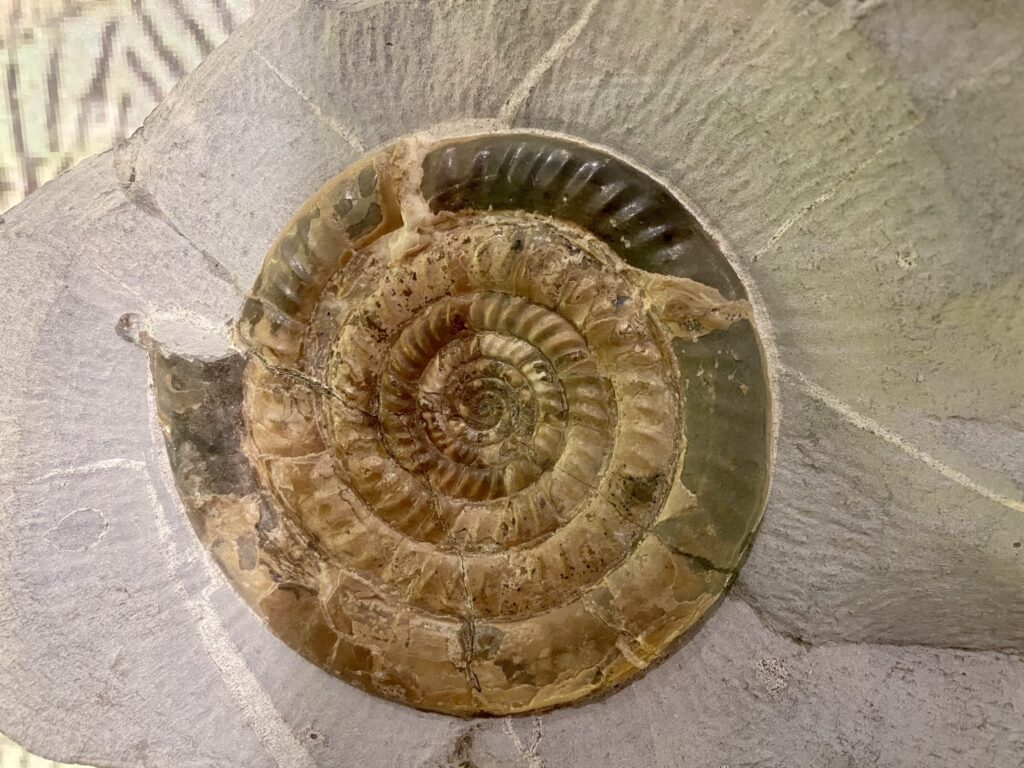
Ammonite from Lyme Regis Museum. Photo: © F.Hardy
Peter Fast forward to Kate Winslet. You had to teach her from scratch how to hunt for fossils and look as if she’d been doing it all her life? Was that difficulty?
Paddy Not really. She’s very game and really put an awful lot of effort into it.
Peter So you have to use the appropriate hammer from the 19th century?
Paddy They haven’t really changed very much, to be honest. One of the things I love about my job is the most complicated tool I use is a bit of metal on the end of a stick.
Felice So did you watch them actually film it in costume?
Paddy Yes, I was on set for some of the time, yes.
Peter You weren’t in costume yourself?
Paddy No.
Felice So you weren’t an extra?
Paddy No. As they say, I’ve got a face for radio really.
Peter So you’re a trained geologist, are you?
Paddy Yes, I have a degree in geology and have been geologist here at the museum for 18 years. I think now probably fossils here since I was six years old. So that’s 49 years.
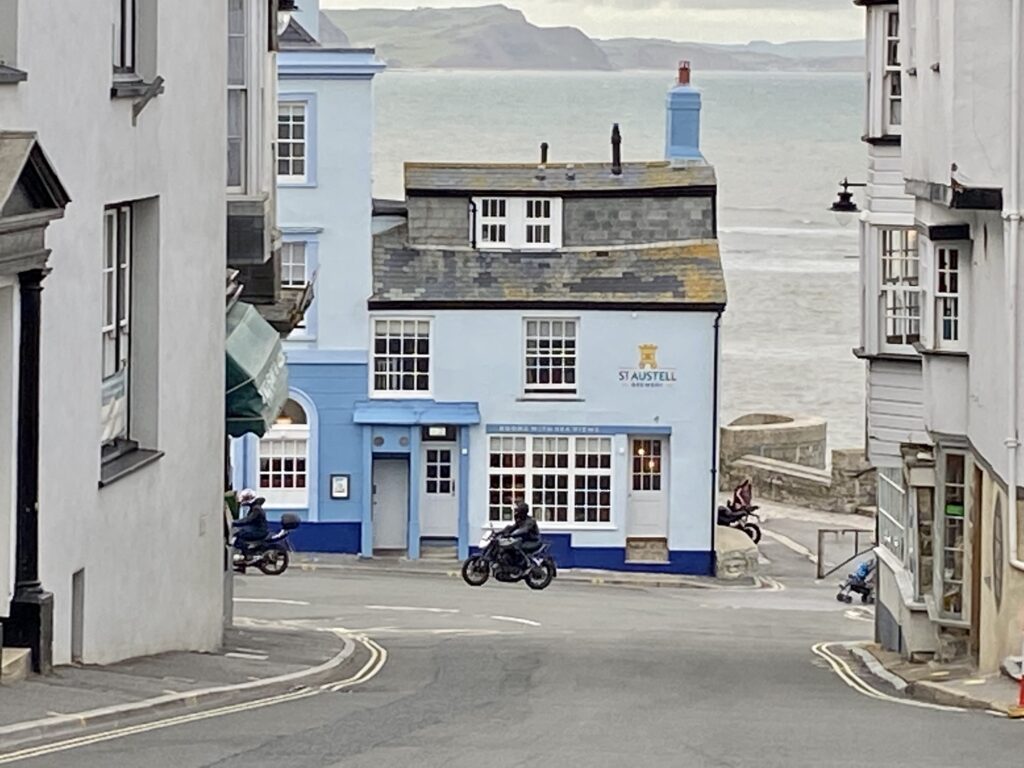
Photo: © F.Hardy
Peter So you’re locally born?
Paddy I’m from Taunton, so 28 miles away. My mother brought me here on a day trip when I was six and I was hooked straightaway. I would get my parents to bring me here as often as possible after that. In my teens, I would cycle the 28 miles from Taunton with my friend, Bob. So we’d cycle down, go fossiling for 10 or 12 hours and then cycle home with a big bag for the rocks, hopefully.
Peter So what do you do with the rocks? I mean, you obviously have rather a large collection at home. You sell them?
Paddy I have sold some, yes. Scientifically important things come to the museum. Anything which is very nice, but not necessarily scientifically important, forms the bulk of my collection at home. And I do sell some everyday things that we would see most of the time.
Peter So Mary Anning has been a central figure of your life?
Paddy Yes, absolutely. An amazing woman to do what she did at that time. You know, women didn’t do that sort of thing.
Peter So tell us a bit more about what you know about Mary. She came from a very humble background?
Paddy Very, very poor. Richard Anning, her father, used to collect fossils and I think showed Mary how to do some of that. But, of course, she went on to make bigger and better discoveries. Yes, it was very much a male preserve at that time. Also, of course, today we have the benefit of some modern clothing. We have waterproof clothes, Wellingtons.
Mary was probably dressed in woollen clothes, things like that. If it’s raining, it’s going to get very heavy and wet. And she’s depicted with a basket over her arm, it wouldn’t take long if that was full of rocks to be in some considerable pain. We have rucksacks and all the modern kit.
Felice And with a long dress, she wouldn’t have been able to move very well?
Paddy It must have made it very, very difficult indeed, assuming, of course, those depictions are correct.
Peter Did you get many women in hundreds or is it a male?
Paddy It still tends to be mostly men, but we are seeing more and more women coming into it, more and more female students coming into it, which is great. And there’s no reason, of course, why that shouldn’t be.
Peter Presumably it can be a dangerous occupation at times because those cliffs are really unstable aren’t they?
Paddy It’s not without risk, of course, but yes, we generally keep away from the cliffs. But there are also a lot of slippery rocks. There are areas a very sticky mud, and people do get stuck on occasion. If you’re hammering a lot sooner or later, you’re going to catch one of your fingers. You know, it’s an occupational hazard.
Peter So, Paddy, what do you think about this new romantic take on Mary’s relationship with her fellow geologist?
Paddy I don’t really have an opinion about that. Just another take on the life of a fantastic woman.
Peter And she wasn’t recognised in her own lifetime.
Paddy She wasn’t allowed to join a lot of the more prestigious associations and societies. And that’s just the way it was at the time, sadly.
Peter She made a living from selling her discoveries?
Paddy Yes, absolutely. Of course, with the advent of the coaching trade, you know, you got more tourists and more people coming to the area. She was very much in the right place at the right time.
Peter I think we’re going to see a huge increase in the number of people who see it as a hobby now.
Paddy Well, we have done in recent years. So every time there’s a new Jurassic Park film, you know, we see a spike in the numbers of people. It used to be, here in the winter, I could go along the beach and not see anybody all day. That hardly ever happens now.
Peter Now you run fossil hunting tours at the beach?
Paddy Yes, I run the fossil walks for the museum and I’m out there probably about 220 days a year. We always find something. I don’t think we’ve ever had a walk when we didn’t find a fossil. We’ve taken over 100,000 people fossil hunting.
Felice Can people do the same on other beaches or is it just this area? I mean, we live near Bournemouth, for example. Could you go to Bournemouth Beach and look for fossils?
Paddy You probably wouldn’t want to be on the main beach there. There are beaches around where you would find fossils, younger fossils than there are to be found here. So things of the year, same period, be around 50 million years old. And there’s an awful lot of places on the coast of Britain where you can find fossils. It’s just Lyme Regis really has the reputation, so people tend to flock to this area in other countries.
Felice Would you ever look for fossil there in other countries?
Paddy The rules are often stricter than they are here. So we’re very lucky. The rules here are extremely lenient. But of course, actually what you’re doing is saving the fossils, because we don’t collect them because it’s a coastal exposure. The sea will destroy them all.
Peter That’s interesting. So in the end, they just disappear will they?
Paddy Yes, they’ll get eroded away the same as the rocks surrounding them often. You know, things we find are bits of things because they already in the process of being destroyed.
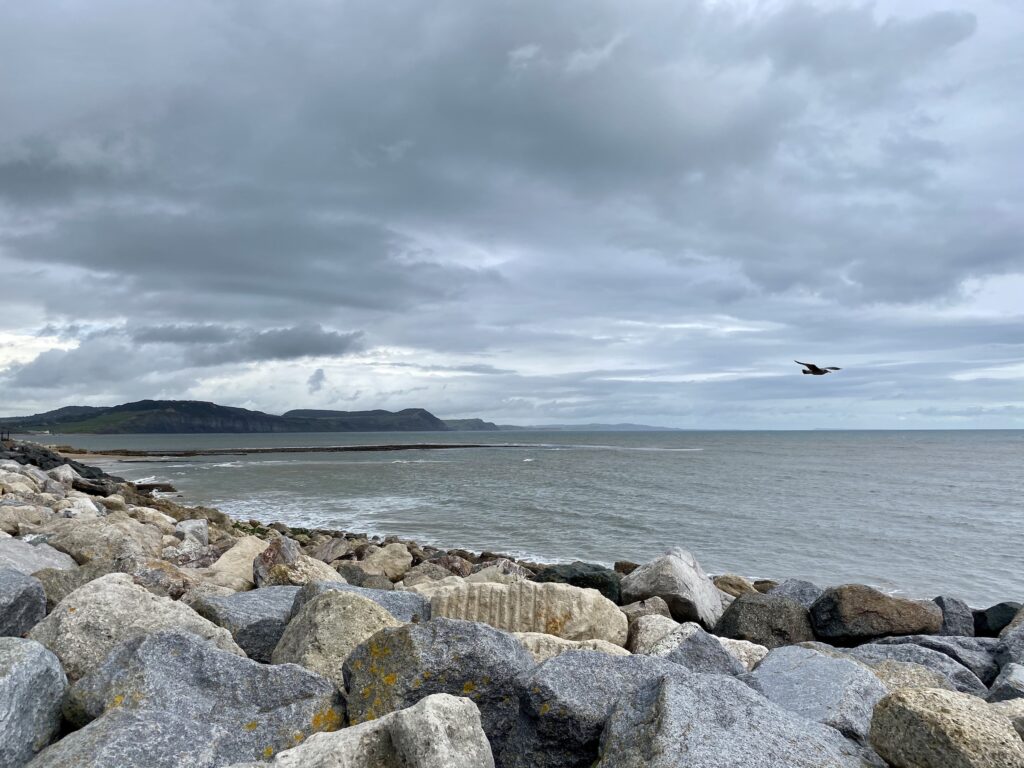
Photo: © F.Hardy
Peter So when you get a cliff fall, then the next storm takes that out to sea?
Paddy Yes. Rocks and mud may fall, the next couple of times will start to spread out over the beach and eventually it will be dispersed. And things will just be ground away to nothing.
Felice So when you chip away at a pebble, do you have to be very careful not to break the fossil inside?
Paddy Sometimes the fossils are softer than the surrounding rock, and that can make it difficult. You need to learn to break them in the right way. And I bumped into a chap a few years ago, who found a lovely ammonite fossil in a stone – and he’d learnt to recognise the right sort of stone, but hasn’t learned how to break it and of course, smashed the thing to pieces.
Peter So did Kate Winslet find anything of interest while you were filming?
Paddy Yes, we found quite a few things: little metal ammonites made of iron pyrite and also Kate found a fragment of the skull of an ichthyosaur.
Peter She got to take it home?
Paddy Oh, yes, absolutely.
Peter And make it into a piece of jewellery or something?
Paddy It’s not a pretty thing – it’s just part of the back of the skull, but it was genuine and she found it herself.
Peter Many thanks indeed…and good hunting. So Felice, do you fancy a bit of fossil hunting this afternoon?
Felice Oh yes. As long as it doesn’t rain and we’re warmly dressed. It sounds quite fun. It takes quite a long time to learn, I should think. I have no idea where to start but I’m sure that Paddy will be very helpful.
Peter Yes, I think we need Paddy’s help here. I don’t think we can do this on our own.
Felice It’s amazing to think that almost everything we’re stepping on might have a fossil in it.
Peter I think it’s going to rain, so maybe we should come back and do this on another day?
Felice Ok, well, there are lots of things to do here when it is raining. Some nice shops,
Peter And more importantly there are some very nice restaurants, so I think we’re going to have lunch.
Felice That’s all for now. If you’ve enjoyed the show, please share this episode with at least one other person! Do also subscribe on Spotify, i-Tunes or any of the many podcast providers – where you can give us a rating. You can also find us on Twitter, Facebook and Instagram. Stay safe and we’ll see you next week.
© ActionPacked Travel

- Join over a hundred thousand podcasters already using Buzzsprout to get their message out to the world.
- Following the link lets Buzzsprout know we sent you, gets you a $20 Amazon gift card if you sign up for a paid plan, and helps support our show.

